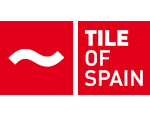Manufacturing process
In recent years, Spanish ceramics has undergone an extraordinary development in all aspects. The industry’s investment in R&D&I has led to products of high technological rigor and quality.
Production process
Spanish ceramic tile production process
Composition preparation phase
Once the raw materials have been selected, they are weighed and dosed to prepare the paste. This process is known as formulation. Thanks to innovation and research, it has been possible to create new formulas for ceramic compositions that help reduce energy consumption in the subsequent stages of manufacture and give the final piece better performance.
The already weighed material is crushed to guarantee its total homogenization through a milling process that is mainly carried out wet to form an aqueous suspension called barbotine, which requires subsequent drying through an atomization process.
Atomization allows obtaining hollow spherical agglomerates of particles, called atomized granules, with a controlled moisture content and with a shape and size suitable for the next stage. The product obtained is called atomized powder.
It is at this stage of the raw material preparation process that cogeneration, a technology that simultaneously provides the heat and electricity needed to carry out this process, has been widely implemented. High-efficiency cogeneration is a key competitive tool for the industry, while contributing to primary energy savings at the national level, with a consequent reduction in CO2 emissions.
In addition, the chimneys through which the water vapor is expelled are equipped with filters and strict controls that guarantee clean emissions into the atmosphere.
Forming stage
With the raw material mixture homogenized and under certain humidity conditions, the product is shaped by means of pressing or extrusion processes.
The most commonly used system in the sector is dry pressing, in which the molding of the parts is carried out by unidirectional pressing. This operation is generally carried out with hydraulic presses whose power used will depend on the size of the parts.
On the other hand, the system used to form the parts from mixtures obtained by the dry process is extrusion forming.
In both processes, thanks to technological innovation and our commitment to the environment, all the water consumed is reused with zero discharge in our companies. The unfired sherds will be reused again to take advantage of the discarded material.
Finally, the pieces obtained are placed in a dryer to reduce their humidity and increase their mechanical strength. The hot gases used in the dryers come from kiln heat recovery systems to reduce energy consumption in the plant.
Enameling and decoration phase
The pieces fresh from the kiln are coated with one or more layers of glaze on the glazing line. This treatment is carried out to give the surface of the fired product a series of technical and aesthetic properties such as gloss, color and impermeability.
Digital printing systems have revolutionized the process of decorating ceramic pieces due to the precision of the finishes and the optimization of resource consumption.
To this must be added the important work in research and development of specialized laboratories in the ceramic industry, which manage to perfect the design of the final products, improving their properties and thus achieving more efficient and environmentally responsible pieces.
Firing phase
The pieces are placed in a continuous kiln where they are subjected to a thermal cycle at high temperatures, obtaining different products depending on the composition, the temperature curve and the duration of the cycle.
This is the most important stage of the production process, where the ceramic tiles undergo a fundamental modification in their properties, giving rise to a hard material with excellent performance.
This process is carried out using single-stage roller kilns that minimize energy consumption by reducing firing cycles.
The sector applies the best available technologies to reduce energy consumption throughout the production process, especially in the firing phase, which is one of the main stages of consumption. Also in product innovation, such as thin pieces that consume less raw materials and energy during the firing phase.
Additional treatment stage
There is a wide range of possible additional treatments, the most common being pre-cutting, surface polishing or grinding and beveling. In these processes, the reuse of water and material leftovers are essential to contribute to the responsible consumption of resources.Sorting and packaging stage
Tile sorting is carried out automatically by means of mechanical equipment and surface observation, in many cases with artificial intelligence.
The result is a perfectly controlled product in terms of dimensional regularity, surface appearance and mechanical and chemical characteristics.
After sorting, the pieces are packaged, where the use of automatic palletizing systems and recycled packaging has become widespread. Thanks to the technological innovation of Industry 4.0, companies have intelligent warehouses in which there is exhaustive control of logistics to ensure that products reach the customer more efficiently and quickly.

